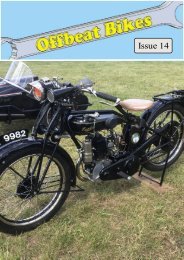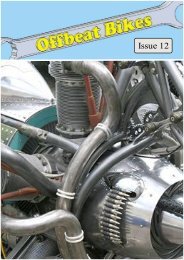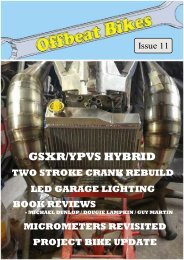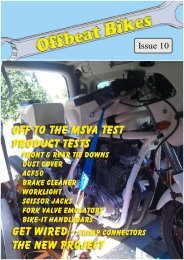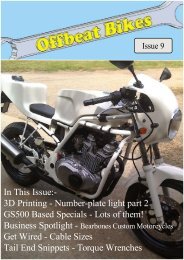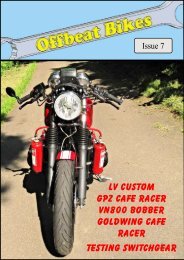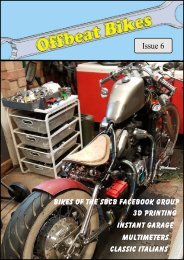Create successful ePaper yourself
Turn your PDF publications into a flip-book with our unique Google optimized e-Paper software.
Issue 17
Contact:- offbeatbikesmagazine@gmail.com
Website:- offbeatbikesmagazine.co.uk
Facebook:- Offbeat Bikes Magazine
Instagram:- jr.offbeatbikes
Welcome to the 17 th issue of the magazine. Hasn’t life
changed in the three months since the last issue. I hope none
of you have been too badly affected by Covid-19. What the
immediate future also holds for us all is still a little uncertain,
although you should be pretty safe self-isolating in the garage
/ shed. So here’s what I recommend:
Stay In (the garage)
Shop Online (for motorcycle parts)
Protect The NHS (use the angle grinder carefully)
Only go out to work (if you need cash for spare parts)
Only make essential journeys (by motorcycle)
Keep building bikes
Finding stuff to put in this issue was a difficult under the
circumstances, especially with no bikes shows or meets
happening. So, I’d like to thank those of you who answered
my pleas for words and pictures about their bikes (including
my mum!).
Next issue will be available online at the end of August. I
wonder what the next three months will bring us.
THE
FACTOR
The CBX after 20 years parked in
the garage.
The Honda CBX550 was not
a big seller, it’s main
competition at the time being
the Gpz550 which was
(according to road tests at the
time) the better machine.
Perhaps people were also put
off by the inboard ventilated
disc brakes. If you weren’t
adept at home servicing and
consequently had to the pay
dealer rates to have your pads
changed etc., maintaining them
was a pricey undertaking.
These brakes also featured on
some of Honda’s other bikes
of the time, early models of
the VT250 / 500 and the
VF400 used the same system -
and they weren’t popular
models either.
Lack of public acclaim does
have it’s good points, though.
If you’re prepared to look past
the brakes, the rest of the bike
is sound and by the mid 90s
you could pick up secondhand
examples for very reasonable
money. That’s exactly what
Colin (this bike’s owner) did,
using this bike as his daily
transport before circumstances
saw it relegated to a life stuck
in the back of the garage.
Fast forward almost 20 years
and, inspired by the new
custom scene of brats,
trackers, scramblers and cafe
racers, Colin decided that he
wanted to have a go himself.
Keen to use what was to hand,
rather than just throw money
at the project, the CBX was
dragged from the garage to
become the donor bike. With
some ideas in his head about
what style he wanted to
achieve and a wish list of the
bits he’d like, he then headed
to one of his favourite haunts -
Kempton Park Bike Jumble -
in search of some bargains.
Some early CAD
(cardboard aided design)
work, to try out some
ideas.
A successful haul of
goodies from the Kempton
Park bike jumble.
Regular visits to the bike
jumble eventually sourced
most of the major components;
Honda 400/4 petrol tank and
cap, alloy front and rear
mudguard, tail light, speedo as
well as sundry other gaskets
and seals. Ebay provided most
of the rest.
Having been started and run
periodically during its
extended stay in the garage,
mechanically it needed little
more than a standard service.
Cosmetically, though, a strip
and refurb was on the cards.
In short order, the 80s
bodywork was stripped off to
reveal the blank canvas of
frame and mechanicals, and
the subframe which was about
to be sacrificed to make way
for a slightly angled seat hoop.
Colin then made his own seat
base out of 2mm aluminium
sheet and (not wanting to
sacrifice the CBX’s original
seat, which was in good order)
purchased another grotty seat
from ebay which donated its
foam to the new project. The
foam was shaped using an
Though mechanically
sound, the bike needed
some cosmetic cleaning
and refurbishment.
electric carving knife and 60
grit paper. With a top layer of
yoga mat foam added, the seat
was then sent to the
upholsterer to work his magic,
using Colin’s drawing as a
template. The seat cover and
the new tyres - MEFO
Explorer Sport - were the two
most expensive parts of the
Seat ready for a trip to
the trimmer’s
project.
The bike already wore a nonoriginal
Motad Neta. It was in
good condition, and as the
stubby design fitted nicely
with Colin’s vision, it was
cleaned, repainted (BBQ
paint) and wrapped ready for
reuse.
Those inboard brakes were
the next items to be tarted up.
The calipers and discs
themselves responded to a
good clean and repaint
(Halfords Wheel Steel). The
master cylinders were another
matter. The rear was replaced
with a cheaper alternative
which worked OK, but did
require Colin to fabricate a
custom adapter bracket to suit.
For the front, the original was
initially cleaned up, but after a
fruitless time trying to bleed
the system, it was discovered
that it needed new seals. With
a seal kit only marginally
cheaper than a pattern master
cylinder from David Silver
spares, the choice was easy
Exhaust system
painted and
wrapped.
and so a new master cylinder
now graces the handlebars.
On to the bodywork, starting
with the tank. The 400/4 tank
was sound but needed a little
work, some primer and 2 to 3
coats of Ford Rio Brown (to
match the bike’s stablemate, a
custom 1971 VW Beetle).
Both alloy mudguards are
Kempton Jumble purchases,
modified to suit, and held in
place using a bespoke mount
fabricated for the front and
tabs welded to the subframe
for the rear. The rear light is a
LEFT: New rear master cylinder sits nicely with the aid
of adapter bracket.
RIGHT: Original front master cylinder was beyond
repair.
BELOW: Brakes themselves came good with a coat of
paint.
TOP: Test fitting the guards
BOTTOM: Mudguards finished - trimmed to length
as required and mounts fabricated.
universal scrambler type, with
flexi number plate.
Side panels have evolved over
time, with saddle bags
(satchels) on both sides
eventually being replaced with
an oval number board on the
near side, the satchel
remaining on the offside. Colin
decided to keep the stock air
box, rather than follow the
fashion for pod filters, and that
choice, together with retaining
a sensible exhaust system, has
‘Side panel’ (to hide air box) was
originally a satchel. Also note the
drilled chain guard.
Satchel has now made
way for number board.
meant that Colin hasn’t had to
suffer the (often frustrating)
process of trying to set up the
carbs to suit, or to just live
with less than perfect fuelling.
Making sure he knew just how
fast he was travelling meant
junking the standard
instruments for a single
centrally mounted speedo.
This required a custom bracket
which was also used to house
the LED idiot lights.
The final job was to wire it all
up. Here, Colin (not being a
fan of electricky and wiring)
enlisted the help of his son.
Without too much trouble,
junior soon had it all buttoned
up and running.
Centrally mounted speedo complete with
custom bracket and LED idiot lights.
The entire project took Colin
18 months (including fitting in
time to rebuild the Beetle
engine) and he is really pleased
with how it all turned out, with
no adverse handling effects
reported from the knobbly
tyres. Using an unusual donor
bike often brings perplexed
looks from onlookers at cafes
and bike meets, much to
Colin’s amusement, as they try
to work out it’s parentage.
Nice bike Colin, now get on
and finish the next one!
Can’t understand
why Colin wasn’t
keen to dive into
the wiring.
Luckily his son
came to the
rescue.
No wonder it confuses people,
you’d have to really know your
bikes to identify this as CBX550.
Colin’s CBX pictured
alongside his son’s 400/4
BOXER TRICKS
You may well have seen these
bikes before, they’ve been
featured in magazines, have
won a plethora of trophies and
a place on display at the UK’s
biggest and most popular
custom bike shows. But I make
no apology for showing them
again here, because there are
still many people that haven’t
yet seen them, they deserve to
be seen and I personally never
tire of looking at them!
Both bikes are based on the
BMW R75/7, just like the one
pictured below. Is it true that
inside every fat bike, there’s a
thin bike trying to get out? It
certainly seems to be the case
with this BMW.
The people responsible for
the transformations are
Stephen Blacker and his
stepdad Malcolm. Despite the
huge visual changes from
original donor bike to finished
bobber and cafe racer, what’s
most surprising is jut how
much of the original bike
remains, albeit modified or
repurposed.
Both bikes started life as
BMW R75/7s
Standard rear subframe
makes way for custom unit
supporting single seat, tail
light and indicators
Bobber was
the first to be
built and
retained
twin-shock
rear end,
although in
modified
format.
Cafe racer is the
latest project. This
time the twinshocks
have been
replaced with a
bespoke monoshock
system.
Once again the
standard subframe
has made way for a
custom unit
designed to
support cafe racer
style seat.
Swingarm and
frame modified to
accept mono-shock
system.
Although the final bikes have
very different styles and rear
suspension setups, the builds
still have a lot in common.
Front suspension is from the
donor bike, lowered 3 inches
and rebuilt, repainted,
polished as required. Both still
use standard wheels front and
rear. These have been stripped,
polished, rebuilt using
stainless spokes and then
finally shod with Firestone
Champion Deluxe tyres.
The airbox (no longer needed
as the bikes run without filters,
relying on a short trumpet and
mesh screen to stop your
trouser legs from being
ingested) has been used to
house the coils and ignition.
Carbs themselves have been
rebuilt as have the engines,
receiving new parts as required
and polishing / painting as
applicable.
Both bikes also use modified
Lucas MCH65 headlamps,
custom engraved fuel caps and
pinstriped BMW silver
paintwork, with decals hand
painted over the clear coat.
Yamaha FS1E tank is used for both builds. Part of one is
also used as the basis for the seat hump.
The other item common to
both bikes is the fuel tank.
These originally graced a much
humbler machines, Yamaha
FS1Es. Exhausts are again
similar, stainless downpipes
and Norton style mufflers,
albeit angled slightly
differently.
Enough of the similarities,
here are the differences.
With the original BMW
subframe removed, each bike
required a custom subframe; a
small one in the case of the
bobber - with just a single seat,
tail light and indicators to
support, a larger version for
the cafe racer to support a seat
hump (formed partly from a
cut down FS1E tank) with
integral tail light and frenched
in indicators. Bobber features
‘upright’ handlebars from a
1970 R90, trimmed to a
suitable width. Cafe racer has
the adjustable ‘Jota’ style bars
orientated for a more racer
riding position, but without
going too extreme. Foot
controls are standard on the
bobber, the cafe racer has
Seat hump designed
to incorporate rear
light and indicators.
Mock-up time. Tank and
seat unit added. Time to
stand back and check that
everything looks ‘right’.
Air box is redundant and now
hides some of the electrical
components.
Cafe racer uses a set of beautifully made
custom rearsets.
Both bikes were rewired
and feature custom made
and engraved fuel caps.
Speedo and
indicator
lights neatly
incorporated
into
headlight
shell
Helmet to match
paintwork. Logos /
decals hand painted on
top of clear coat.
Stephen readily admits that
the bikes were built for show
and short cruises, rather than
for racking up the miles, but
both do get ridden. When
pushed for an answer to the
‘Which do you like best?’
question, he avoided offending
either bike by saying he likes
the looks of the cafe racer, but
the ride of the bobber. Either
way, they’re both very nice
bike and a credit to their
owner and everyone else who
was involved in their build.
Stephen has in mind another bike that he’d like to build,
but first he needs to raise some funds. To that end, if
anyone is interested in purchasing one of his current
creations, you can contact him on: Mobile
07971487759 Email Stevieceecee@live.co.uk
Fancy sharing your life
with a little Italian? This is
another one of Stephen’s
bikes, bought as a box of
bits, the bike’s now fully
reassembled. It’s a 1966
Motobi Imperiale 125cc.
The spec sheets reads like
a who’s who of Italian spares manufacturers; Silentium silencer,
Tommaselli twist-grip, Giuliari seat etc. It’s another bike that
Stephen is willing to part with to help finance further project
builds. If you are interested and want further details, contact
him by phone on: Mobile 07971487759 or Email:
Stevieceecee@live.co.uk
A RUMI WITH A VIEW
I’m pleased to introduce the
first (if my memory serves me
correct) female contributor to
the magazine other than
myself. Still keeping it in the
family though as it’s my mum.
She has, over the years,
regaled us with the stories of
her moped years. I’ve heard
them many, many times, so
it’s only fair that you lot
should suffer too. So here
goes…
After a few traumatic outings
with my father in his 1939
Jaguar, I progressed to driving
lessons in a Ford Anglia and
passed my test in June 1961.
By then, Dad had upgraded his
No pictures exist of the actual scooter, but
it looked something like this.
Jaguar and I thought my
freedom had arrived!
(Grandad had all kinds of
interesting vehicles, a Willys
Jeep, the Jaguars etc., but all
before his grandchildren
came along. The first one I
can actually remember was a
Hilman Hunter!) But the car
was not always available, was
expensive to run and I
couldn’t afford to buy my
own. Following extensive
family ‘discussions’ I was
allowed to start looking for
something with two-wheels,
motorised of course. (Funnily
enough there were more
‘discussions’ many years
later when my
sister wanted to
venture on to
two-wheels.
Mum wanted her
to get a moped,
my sister wanted
a proper
motorcycle,
hence the oft
heard cry during
Moto Rumi are one of the
least known Italian motorcycle
and scooter companies,
probably because they weren’t
around for very long.
Pre WW2 they manufactured
cast aluminium components for
the textile industry. During the
war, their expertise was put to
use in the manufacture of submarines and torpedoes.
Post war, in the early 1950s, they tried their hand at
motorcycle production. Although they made a few
‘proper’ motorcycles, most of the models that made it
to the UK were scooters, using aluminium castings to
produce a monocoque chassis that housed a two stroke
twin horizontal engine.
By the 1960s it was all over and the company went
into liquidation,
Bol d’Or model was one of the last
produced and celebrated their achievements
on the race track.
these discussions of ‘I’m not
having a step-through!’ She
didn’t, eventually ending up
with a YB100 as a first bike.
Thankfully her winning the
argument meant that my own
progress on to two-wheels
was much easier.
When a for sale advert
appeared in the local press for
a 125 Rumi scooter, I was
soon on the trail. After a test
ride on a local disused airfield
I was hooked. This was only
marred by realising that
sometime during the test ride
that I’d lost my wallet.
However, after a return trip to
the airfield, retracing my route,
the wallet was found.
Once home, the quest for
riding gear began. An open
face helmet and a fetching
jacket and trousers outfit,
made from simulated leather
(vinyl) fitted the bill. Not
being the slimmest of teenagers
(that’s not changed with the
passage of time) I looked a
little like the Michelin
(Wo)Man.
After a few months of riding, I
booked a test. My memories of
this are rather vague. The
examiner outlined the route to
take and at various points he
would appear, he’d also at
some stage wave his clipboard
for an emergency stop. As I
attempted to kickstart the bike,
the lever sprang back and
grazed my ankle (I had no
fancy riding boots). This was
rather painful and not the best
way to start a test, but despite
the blood dripping down my
ankle, I passed the test and so
(much to the amusement of the
younger members of the
family) still have full
motorcycle entitlement on my
driving licence.
There followed many months
of happy riding, mostly
without incident, but there
were a few more ‘entertaining’
moments along the way. I had
a 14 mile journey to work, the
first part of which was through
some narrow country lanes.
Imagine my mother’s horror
when within half an hour of
leaving one morning, I was
back, clambering out of the
cab of a lorry mounted crane,
with my bike suspended from
the jib at the front. I met the
crane on a blind corner, pulled
off onto a soft, muddy verge
and ended up on the floor.
Apart from slightly bent
handlebars and being covered
in mud, both the bike and I
escaped relatively unharmed.
The rest of the journey was on
the A45 (now A14) where my
chief delight was to catch up
with, and then overtake, a
work colleague. He only had a
Lambretta, no match for the
mighty parallel twin, 125cc
Moto Rumi.
Luggage carrying was
restricted to an attache case
strapped to the rear carrier.
My lunch successfully made
the trip to work many times in
this way, except for when I
decided to take a flask of
tomato soup - the vibration of
the Rumi managed to shatter
the flask and spread the
contents liberally over
everything else in the case.
That’s not the only time food
has suffered on the carrier of
the Rumi. (Food often suffers
in Mum’s hands - she has
actually managed to boil
soup dry!) On another
I’m not sure of
exactly what make
of crane the scooter
ended up being
suspended from, but
I’ve always
imagined that it
looked like Lofty.
occasion, I had a tin
containing a cake for a charity
stall strapped to the carrier.
Imagine my surprise, when on
a steep downhill descent, the
tin (complete with cake)
overtook me.
One Sunday, I ventured back
to my home county of Essex to
visit some relatives. All went
well until the return journey,
when a policeman was
stopping traffic at the bottom
of the hill in Bocking. I pulled
in the clutch, but the nipple
came off the cable, leaving me
still approaching the copper at
speed. Thankfully, I managed
to slither to an ungainly halt
before I hit the bobby. And he,
after listening to my
explanation of why I’d nearly
run him over, was kind enough
to direct me back up the hill to
a garage who might be able to
help repair the cable. He
didn’t offer to help me push it
up the hill, though.
Then, as of now, the weather
often has an influence on how
much you’re enjoying the ride.
During wet weather, the
Rumi’s plugs (situated low
down behind the front wheel
and thus in the firing line of
any spray) often caused
problems, but I soon got used
to sorting them out.
The worst weather to ride in
was snow, but when the
weather was good, nothing
came close to the sense of
freedom that a scooter had
given to a teenager.
I passed the bike on to my
brother-in-law and that was
the end of my two-wheeled
exploits. The bike was
eventually scrapped, such a
shame as similar models are
worth between £5000 to
£6000 pounds now.
Despite having got rid of the
Rumi before either of her
children arrived something
must has travelled in the
genes as both her daughters
had and still have
motorcycles. She complains
that we won’t let her ride
them. This is not strictly true,
every year I offer her the
opportunity of riding my
bikes to their MOT tests (I
never like that journey) but
she always declines.
On first glance this bike looks
like it has Harley Davidson
heritage, but the Davidis
Victorson has sports bike
genes, in the form of a bright
yellow Suzuki TL1000. Dave
(the bike’s owner) wanted to
build a bike to commemorate
the 10 th anniversary of his
dad’s death - in whose honour
the bike is named. Not having
all of the required skills, he
enlisted the help of long term
bike building friend, Oz. (Oz
honed his skills working at
Desperate Dans, before
branching off on his own.) The
only specifications were; hardtail
bobber, japanese engine.
Other than that, Oz had free
reign.
Having settled on the Suzuki
as a donor, Dave and Oz
stripped the bike to its
component parts in short
order. While Dave had the task
of overhauling the ancillary
components - forks, brakes etc.
- Oz started work on the
frame. The engine was hoisted
onto the fabrication table and
with rear axle and headstock
positions fixed, the frame
design began to evolve.
The donor bike
Suzuki TL1000R
Once headstock and rear
axle points are fixed, frame
is designed around the
engine.
Time to stand back, look and take stock -
and work out handlebar design and position.
After two years of late nights
and long days, the bike was
finally finished. It was
everything Dave wanted. He
loved the sound. It handled
well and for a hard-tail it was
fairly comfy. It’s first proper
trip was a 50 mile round trip
for an MOT test. It duly
passed and Dave was set to
enjoy the fruits of his labours
with some chilled out rides
around the countryside.
Except, the Suzuki engine had
other ideas…
Dave’s had many bikes, but
the only ones that have given
him trouble have been
Suzukis. It seems that that jinx
was still active as on the very
next ride the clutch started to
feel a little odd. Removing the
clutch cover on his return
home revealed that a bolt had
made a bid for freedom and in
the process had also created
lots of metal swarf. This was
repaired as required, but by
now, the riding season was
over so the bike was tucked
away and left to hibernate
until spring arrived.
Wiring often strikes fear into
the heart of many a bike
builder, but Oz and Dave got
this successfully sorted.
All
painted
and final
build well
underway.
Clutch issues
sidelined the bike
shortly after it first hit
the road…
Fast forward to February, Dave’s
completing his pre-flight checks
for the first rides of the year,
when he notices that the Suzuki is
swallowing more coolant than
he’d expect to need for a simple
…but that was soon
rectified.
top-up after a winter of laying
idle. It started and ran OK, but
Dave then noticed the colour of
the oil in the sight glass. The
Suzuki curse had returned again.
This time the culprit was the
core plugs. At this point, I think
some rude words were said.
Replacing the core plugs meant
Core plug failure over winter lead to
this coolant/oil mix and precipitated
an engine rebuild, complete with
capacity hike.
that the engine needed to come out of the frame. Dave removed it
and then entrusted it to TL1000 guru, Sam Matthewman. Sam
was instructed to fully check the engine to ward off any further
trouble. Sam just happened to mention that he also did big bore
kits for the TL, was Dave interested?
The engine is now rebuilt and back in the frame, and with the
addition of some extra cubic centimetres is now ready to make
even longer black lines!
I think Oz and Dave have created
a very special bike, a fitting tribute
to Dave’s late father.
Product Reviews
Gammatronix
Battery Monitor
After experiencing some
electrical problems with the
(often abused and neglected)
GS500, it was decided that
some kind of battery monitor
would be useful to provide a
visual indication of any
potential charging issues. A
quick ebay scan produced the
usual choice of cheap products
from China, any of which
would probably have done the
job. But, for not much more
money, you could buy a
British built product, and keen
to support a small company
that is actually making its own
products, one was purchased.
Gammotronix, make a range
of battery / voltage
monitors (as well as basic
electronic ignition
systems). Their J model
was chosen, not just
because it was the
cheapest, but because it
would also operate on a
range of different voltage
systems, and had six
different operational
modes ranging from a minimal
current drain voltage monitor
to full blown charging system
indicator, which increased its
versatility. The only downside
- as supplied, it isn’t
waterproof. (Gammatronix
also sell a similar, fully
waterproof version, but it
doesn’t have all the features of
the J model.)
The state of charge /voltage is
indicated by the colour of the
led (its a tri-colour led,
capable of showing red,
yellow and green, steady or
flashing to further increase the
resolution of the unit). It is
intended that fitment is
permanent, and as such, it will
also give a visual indication of
the state of your battery during
storage, great over winter, or
during a Coronavirus
pandemic - just keep an eye on
the led indicator and plug in
the battery charger when
required. Useful if you have
more than one bike, but only
one battery
charger/conditioner.
However, being far too tight
to stump up for one for each
bike, this unit would have to
be portable between the
various bikes currently
inhabiting the garage. Anyway,
being pretty good at
remembering to periodically
connect up the charger to keep
the batteries topped up, I was
more interested in using it as a
charging system monitor when
actually riding the bike and I
can only ride one of them at a
time. The plan was to make a
housing (using the 3D printer)
to protect the unit from the
rain that would also allow it to
be swapped between bikes. I
say was, because to be honest
it isn’t finished yet, other stuff
has got in the way, but here’s
the progress so far…
First off some fused leads
were made up that could
stay permanently
connected to the bike’s
battery. Ring connectors
on the battery end, the
connector on the other
end chosen to fit both my
battery charger and the
battery monitor. The cover
on the end (to keep the crud out when not being used)
was made from heatshrink tubing - not pretty, but it does
the job.
ABOVE: Trial fitting of the unit in the printed
housing, U shaped cover clips over the top to
keep the rain out.
BELOW: Cover in place, sleeving added to
protect the connecting wires and connector to
match
permanently
attached battery
lead added.
The whole
assembly is
then tested by
connecting it to
a 12V power
supply - and it
works!
RIGHT: Although
the led could
clearly be seen
through the plastic
of the housing
indoors, outside in
the sunlight it
wasn’t. It needs a
clear insert to make
it more visible.
BELOW: Section on bicycle inner tube holds
cover securely in place, and that’s as far as this
little project has got. I need to work on designing
mounts for the different bikes it’s got to fit. But
then I need to do lots of other stuff as well…
BOOK REVIEWS
Ring Of Fire - The Inside
Story of Valentino Rossi and
MotoGP
Rick Broadbent
ISBN 978-0-593-06263-0
That Near-Death Thing
Rick Broadbent
ISBN 978-1-4091-3897-6
Rick Broadbent is a well
respected sports writer, writing
for ‘The Times’, as well as
penning books on a wide range
of sporting topics.
These particular books were
published a few years ago
now, ‘Ring of Fire’ in 2009
and ‘That Near-Death Thing’
in 2012, so they’re not
current, but a good many of
the racers featured are still
going and those that aren’t
will still be familiar names to
most people interested in the
sport.
Ring of Fire concentrates
mostly on the 2007 - 2008
years and is an interesting look
into life in the MotoGP
paddock. It goes behind the
sanitised scenes portrayed on
TV and reveals more about the
characters of the main
protagonists. Those brief after
race interviews, which, with all
racers being heavily schooled
on PR nowadays, often don’t
tell you very much - apart
from how great their sponsors
are. And a rider’s own
autobiography will only tell
you what they want you to
know. It’ll still be the version
of themselves that they want to
portray, rather than the true
person. Rick has obviously
spent enough time in the
paddock to get a feel for the
general vibe that exists around
the main characters and so can
temper what they say with
how their words are
interpreted by, and effect, the
people around them. And if
you think that all of the racers
lock themselves away in their
motorhomes once racing has
finished (well some do) you’ll
also find that paddock high
jinks are still high on the
agenda.
Rick also make comparisons
between the racing and star
riders of different decades, and
this is interesting, but, for me,
it is also the most annoying
thing about Rick’s writing
style. The chapters are
constantly jumping between
different riders, different races,
different decades etc. and that
often leaves me a little
frustrated. It’s like he’s part
way through telling a story and
you’re interested in hearing
what happens, but instead of
finishing it, the next chapter
disappears off to another time
and place. It means that by the
time the book gets around to
finishing a story, I’ve forgotten
start of it. That’s my only
gripe, though. Apart from that,
the book is good, well
researched and if you like
reading about bike racing, you
won’t be disappointed.
That Near-Death Thing
essentially does the same for
the Isle of Man TT, this time
concentrating on the 2010 /
2011 races. The book follows
a handful of well known racers
(Guy Martin, John McGuiness,
Conor Cummins, Michael
Dunlop, Jenny Tinmouth etc.)
and chronicles their ups and
downs, successes and failures,
crashes and recoveries.
The book also picks up on the
vibe of the paddock and the
racers themselves.
Unsurprisingly, it’s a very
different world to motoGP.
For all of their commonalities
(riding motorcycles quickly)
the two arenas require totally
different mentalities and skill
sets. I doubt a TT racer would
ever feel comfortable in the
motoGP paddock and viceversa.
Once again, as you would
expect, the writing style is
similar, with chapters jumping
in time and space. It makes it
hard for me (a person of very
little brain) to keep track of
the narrative. The layout
doesn’t work for me, but you
can’t really argue with the
content. It is a well researched
book, the author has taken
great care to get a true feel for
what makes the TT racers tick.
Both books are available via
Amazon, in paperback or
kindle format. ‘That Near-
Death Thing’ is £3.00 in
paperback, £3.99 kindle.
‘Ring of Fire’ is £9.99 for the
paperback, kindle £4.99.
Those are new prices.
Secondhand editions are
cheaper, especially for ‘Ring
of Fire’.
Automotive Machining - A
guide to decking, honing and
more.
Mike Mavrigian
ISBN: 978-1-61325-283-3
I came across this book by
accident while idly browsing
Amazon. Their price was a bit
steep at £26, but one of the
third party sellers had it for a
smidgen under £15 - a much
more attractive price. I wasn’t
sure how interesting it would
be since it was obvious from
the description that it was
aimed more at describing the
equipment that a fully tooled
automotive shop would use
rather than your average shed
builder. I also thought that it
might be a bit light on
information - just pretty
pictures with descriptions no
more in depth than this is a
boring machine, this is a
honing machine etc. The other
negative point was that it’s
American, which means
everything’s in inches.
Anyway I decided to invest
£15 and find out - and I was
pleasantly surprised. Yes, it
does only describe the
automotive machining
processes used by professional
engine rebuilders, but the
information it contains is
almost to text book level. But
it’s better than a dry old text
book that you’re supposed to
read from cover to cover. You
could do that with this book,
but it is illustrated with lots of
pictures of engines undergoing
various processes, with
descriptive captions, which
also makes it a book that you
can flick through, stopping to
read a bit more in depth when
a picture piques your interest.
For someone who has some
general machining knowledge,
either through work or hobby,
but wants to know more about
specific automotive processes,
this would be a good start and
I could see some of the more
inventive ones working out
how they could adapt the
processes for use in a more
basic machine shop
environment.
I enjoyed it, as you can
probably tell, and I think it
was well worth £15, but at the
full price, I’m not so sure.
A brief round up of our latest projects
Progress has slowed on
the dirt bike, mostly due
to the arrival of the Moto
Morini Corsarino, which
has been a distraction, but
also because making the
fibreglass moulds and
moldings is time
consuming. However, the
air box is now made and
the air boot is also now
made - although not
without cock-ups!
Next for this project will
be making the inlet
manifold. Currently it’s a
3D printed mock-up. I
need to make an
aluminium version. I have
the choice of trying to
machine one from solid,
fabricating one (but I have
no aluminium welding
facilities) or casting one -
something I’ve never tried
before. I’m still thinking
this through…
Air box mould - top picture -
produces an air box that
(thankfully) fits the gap.
Follow these projects in the
weekly updates posted on
the Facebook page &
Instagram, or for more
detail, visit the Website.
ABOVE: 3D CAD drawing of
the inlet manifold that I need
to make - somehow…
RIGHT AND BELOW: Air
boot mould and moulding. I
messed up here, forgot to add
catalyst to gel-coat!
It all started with the simple act of removing the front wheel to
see why the brake action was so poor. Removing the wheel, it
became apparent that there was a lot of play in the front forks.
These forks are a simple design, just springs and bronze bushes,
there’s no oil or seals to worry about. The two parts of the fork
leg are held together by the spring, which is just used like a
large screw. Taking them apart it was apparent that not only
were the bushes worn, but the springs were past their best and
the upper legs were bent. The upper legs are just 1 inch
diameter ERW tube. It wouldn’t need much force from an
impact to bend them. Legs were duly made straighter with the
aid of a hydraulic press and new bushes turned. With the
addition of new springs, everything should now just bolt
together - right?
Wrong! It wasn’t just the forks that were a bit kinky, turns out
that the yokes had had a tweak as well. Inspection revealed that
New tyres, new tubes, new
fork springs - this bike is
thoroughly spoilt!
these already had a nonfactory
weld, so
someone had been here
before me.
Unfortunately, it seems
they welded it to
compensate for the bent
forks, now with
straight(er) forks, the
wheel pointed off to the
right and no amount of loosening
bolts and tweaking could get it
anywhere near straight. The only
solution was to cut through their
weld repair and have a go myself.
Eventually the wheel and
handlebars were made to point in
the same direction and I could look
at the brakes. Operating the brakes
Handlebars straight,
unfortunately the wheel’s
pointing off to the right.
With the bottom yoke / fork shrouds rewelded,
wheel and handlebars point in the
same direction and straightedge shows that
wheels are in line.
by hand and watching the
shoes move, it was obvious that
one was moving further than
the other. The culprit must
then be the actuating cam.
Flicking the shoes off to access
the cam revealed another
‘repair’. I thought about
building this up with weld and
then attempting to machine it
Roughing out new
brake cam on the
lathe.
there’s nothing to lose. At the
very worst I’ll make something
that doesn’t work, but I’m sure
to have learnt something along
the way. Luckily, this seems to
fit Ok.
So, the front end is now back
together, complete with new
tyre and inner tube. Now let’s
see what challenges the rear
end of the bike throws up…
Brake cam
has seen
better days!
back to size, but instead,
decided that it would be easier
to start from scratch and
machine a new one. Along
with fork bushes, machining a
brake cam was not something
that I’d tried before, the
Corsarino is certainly
providing some challenges, but
Finished
cam, fits
but needs
road test.
A big thank you to everyone who has taken the
time to provide content. It is (as always) very
much appreciated.
Well, that’s it. The end of the seventeenth issue.
If you’d like your business (motorcycle related) to be
featured in the magazine, get in touch - there’s no charge!
Email: offbeatbikesmagazine@gmail.com
Content for next issue by August 24 th please.







